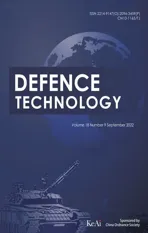A pixel-level local contrast measure for infrared small target detection
2022-09-22ZhaobingQiuYongMaFanFanJunHuangMinghuiWuXiaoguangMei
Zhao-bing Qiu,Yong Ma,Fan Fan,Jun Huang,Ming-hui Wu,Xiao-guang Mei
School of Electronic Information and the School Aerospace Research,Wuhan University,Wuhan,430074,China
Keywords:Infrared(IR)small target Irregular size Random walker(RW)Pixel-level local contrast measure(PLLCM)
ABSTRACT Infrared(IR)small target detection is one of the key technologies of infrared search and track(IRST)systems.Existing methods have some limitations in detection performance,especially when the target size is irregular or the background is complex.In this paper,we propose a pixel-level local contrast measure(PLLCM),which can subdivide small targets and backgrounds at pixel level simultaneously.With pixel-level segmentation,the difference between the target and the background becomes more obvious,which helps to improve the detection performance.First,we design a multiscale sliding window to quickly extract candidate target pixels.Then,a local window based on random walker(RW)is designed for pixel-level target segmentation.After that,PLLCM incorporating probability weights and scale constraints is proposed to accurately measure local contrast and suppress various types of background interference.Finally,an adaptive threshold operation is applied to separate the target from the PLLCM enhanced map.Experimental results show that the proposed method has a higher detection rate and a lower false alarm rate than the baseline algorithms,while achieving a high speed.
1.Introduction
As a key technology for infrared search and track(IRST)systems,infrared(IR)small target detection is widely used,especially in military early warning systems[1—4].Due to the principle of infrared imaging and the long detection distance,IR small targets usually do not have a fixed size and specific shape[5,6].In addition,heavy noise interferences and complex background clutters,such as pixel-sized noises with high brightness(PNHB)[7]and large area background with high brightness(LABHB),greatly increase the difficulty of detection[8—10].Considering that the IR small target size ranges from 2×1 to 9×9 pixels[11],LABHB refers specifically to the highlighted area that is larger than 9×9 pixels.Due to these reasons,IR small target detection still remains a challenging issue.Generally speaking,the IR small target detection methods can be divided into two main categories:track-before-detection(TBD)methods and detection-before-track(DBT)methods.TBD methods,such as temporal profile filtering[12],self-adaptive caliber temporal-spatial filtering[13],and high-order cumulant of motion estimation[14],achieve target detection by assuming that targets in consecutive frames have consistent gray levels and continuous trajectories.On the one hand,these assumptions limit the practical application of TBD methods;and on the other hand,the processing of consecutive frames limits the detection speed[15—19].In comparison,DBT methods directly process one single image without more assumptions[20—22].Due to the real-time and robustness,DBT methods have attracted more and more attention.Therefore,we focus on DBT methods in this paper.
Traditional DBT methods,such as Max-Mean/Max-Median filter[23],wavelet filter[24,25],Top-Hat filters[26]and bilateral filter[27],have been first proposed for enhancing the saliency of IR targets.However,they have poor detection performance in complex scenes.Subsequently,principal component analysis(PCA)technology is widely used in infrared small target detection to better suppress complex backgrounds[28—32].PCA-based methods treat the infrared image as consisting of a low-order matrix representing the background and a sparse matrix representing the small target.However,the background in the image can be well represented by the low-order matrix only if it conforms to the non-local auto-correlation.Therefore,PCA-based methods aredifficult to remove abnormal background clutters such as PNHB and LABHB.Methods based on deep learning[33,34]have made some progress in suppressing complex backgrounds.However,they require a large number of multi-scenario training samples that are difficult to obtain in practice.
Methods based on human visual system(HVS)have been extensively studied due to their effectiveness and real-time performance[35—42].The main motivation for HVS-based methods stems from the fact that small IR targets are usually brighter than their surrounding background.Single-scale local contrast measure(ILCM)[7]is first proposed to detect targets by measuring local contrast,but it cannot detect targets of unknown sizes.In order to effectively detect targets of different sizes,many multiscale methods have been proposed,such as LCM[43],MPCM[11],and ADDCDD[44].However,regular windows used in multiscale methods cannot accurately represent irregular targets and measure true local contrast[45—47].For example,when the target is not a regular size(shown in Fig.1),the result of MPCM appears“target suppression”phenomenon.At this time,the target with higher contrast is weakened,and the background clutter is mistakenly detected as the target.The reason is that the target area represented by rule windows takes the adjacent background as part of the target.As a result,multiscale methods weakens the saliency of irregular size targets,leading to a high false alarm rate.
In order to accurately represent irregular targets,Xia et al.apply random walk(RW)technology[48—50]to separate small targets from the background and proposed modified random walks(MRW)[51].Nevertheless,MRW does not consider the target size issue and cannot remove PNHB.Subsequently,Qin et al.propose facet kernel and random walker(FKRW)[2]to remove PNHB.However,it does not subdivide the background and cannot accurately measure local contrast in complex backgrounds.As shown in Fig.1(c),FKRW eliminates most of the clutter,including neat LABHB.However,FKRW cannot remove cluttered LABHB,which still leads to the“target suppression”phenomenon.
To solve the“target suppression”problem,we propose a novel RW-based method,which subdivides the target and background at the pixel level simultaneously.As shown in Fig.2,the proposed method consists of four main steps.Firstly,a multiscale window structure is designed to extract candidate targets.Note that candidate targets refer to pixels that are more likely to be targets.Then,we design a novel window based on random walker(RW),which can achieve pixel-level segmentation of the target and background.After that,we calculate the pixel-level local contrast measure(PLLCM)for each candidate target,which combines probability weights and size constraints.Probability weights measure more accurate local contrast to suppress low-contrast backgrounds,and size constraints remove high-contrast LABHB based on the actual size of candidate targets.Finally,real targets are detected by the adaptive threshold operation.As shown in Fig.1(d),our method removes almost all background clutters and effectively solves the“target suppression”problem.The characteristics and contributions of this paper are summarized as follows:
1.In order to measure local contrast more accurately,a novel RWbased local window is designed to subdivide small targets and backgrounds at the pixel level.
2.We propose PLLCM incorporating probability weights and scale constraints to efficiently eliminate complex background clutter.
3.To demonstrate the effectiveness and robustness of our method,more than 1000 real IR images are used in our experiments.Various simulation and experimental results show that the proposed method has better robustness and detection performance than several state-of-the-art methods.
The remaining part of this paper is organized as follows:Section 2 describes the proposed IR small target detection method based on PLLCM in detail.Various simulations and experiments are conducted to demonstrate the effectiveness and robustness of our method in Section 3.Finally,conclusions and discussions are presented in Section 4.
2.Proposed method
Fig.2 shows the flow chart of the proposed method.Our method is mainly divided into four steps.Firstly,candidate target pixels are extracted in IR image by multiscale sliding windows filtering and threshold segmentation.Then,an RW-based local window structure is constructed for each candidate pixel.After that,PLLCM for each candidate pixel is computed for constructing the enhanced map.Finally,real IR targets are detected by adaptive threshold segmentation of the enhanced map.
2.1.Candidate target pixels extraction
In order to improve the detection speed,we design a multiscale window structure to extract candidate target pixels.We use Mto denote the window with a scale of L×L pixels.The center pixel,outermost pixels,and other pixels values of Mare set to(4×L-4),-1,and 0,respectively.
Fig.3 shows the specific structures of Mand M.The raw IR image filtered by Mis represented by Fas follows:

where I represents the input IR image and*represents convolution operation.We use F to denote the image after the multiscale operation.For a pixel(x,y)in F,its intensity is defined as follows:


Fig.1.“Target suppression”phenomenon(the red rectangles denote true targets,the blue ellipses denote false targets due to inadequacies in the algorithms,and a close-up view of the irregular target is shown in the lower left corner of the IR raw image).
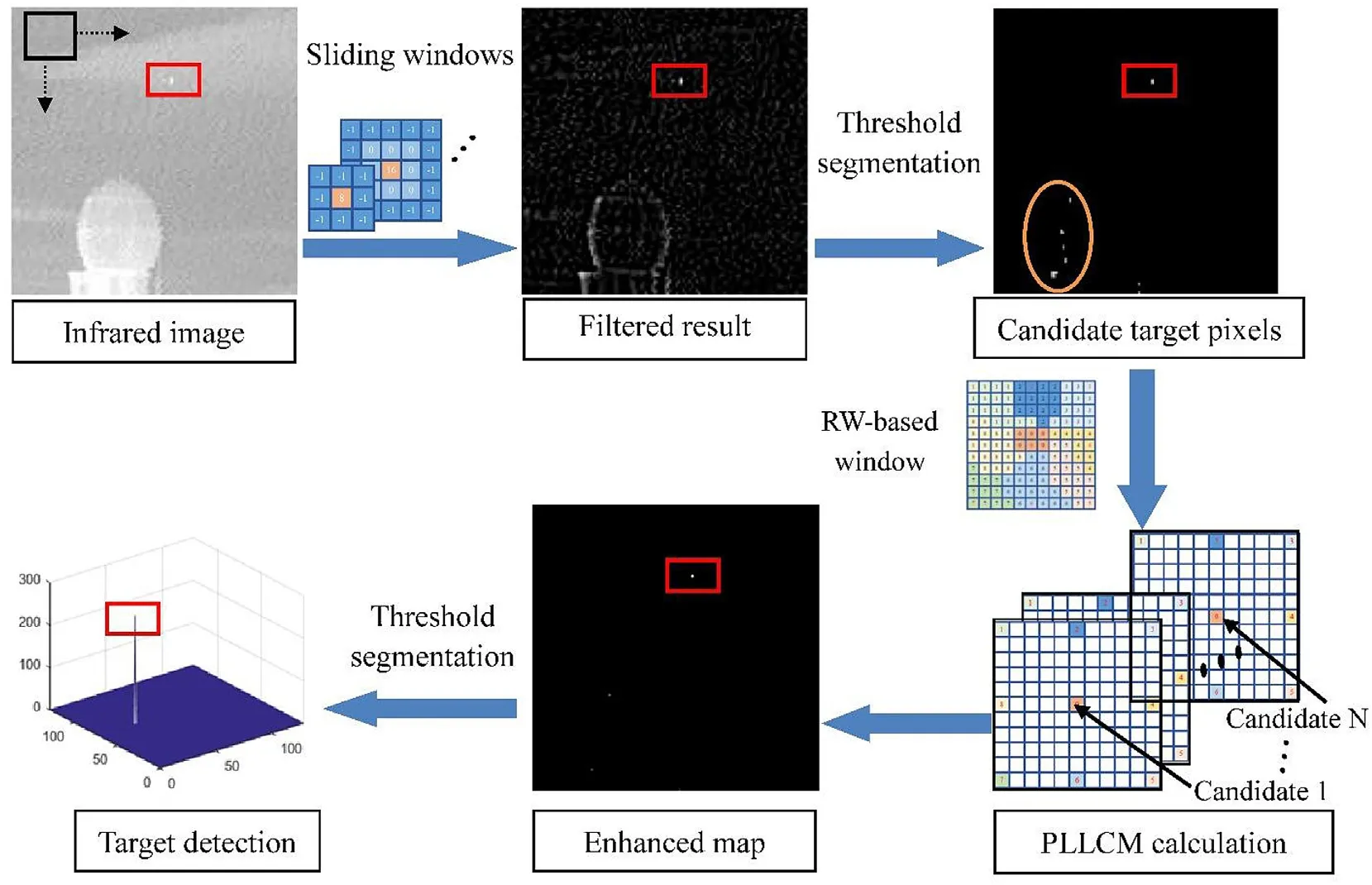
Fig.2.Schematic diagram of the proposed method.

Fig.3.Sliding windows of size 3×3 and 5×5.
Filtering an IR image with the multiscale window structure can roughly measure the local contrast of each pixel.In F,pixels with high intensity are more likely to be targets.Therefore,we use an adaptive threshold operation to extract candidate pixels.The adaptive threshold This defined as follows:

where μand δrepresent the mean value and the standard deviation of F,and kis an empirical constant.The specific value of kwill be discussed in Section 3.Therefore,pixels with an intensity higher than Thare selected as candidate pixels.
2.2.Construction of the RW-based local window
As a classical supervised clustering method,random walker(RW)is widely used in image segmentation[49].However,it is difficult to obtain satisfactory segmentation results by directly applying RW to an IR image.Therefore,we design a RW-based local window structure specifically for IR small target detection.
Fig.4 shows the schematic diagram of our constructed RWbased local window.Since small targets only occupy from 2×1 to 9×9 pixels in an IR image[29],segmenting the whole image with RW is time-consuming and inaccurate.On the contrary,segmentation in a too small local area will easily miss the real target.Therefore,we choose a square area of 11×11 pixels centered at each candidate pixel as the segmented local area.As in FKRW,simply dividing the local window into a target area and a background area leads to its unsatisfactory segmentation results in complex backgrounds.In order to accurately separate irregular targets even in complex backgrounds,we divide the local window into a target area and eight background areas as shown in Fig.4.Specifically,the candidate pixel in the center is labeled as category 0 and the eight outermost pixels of the local window are labeled from category 1 to category 8,respectively.To perform RW,we consider the RW-based window as a graph G=(V,E)with nodes(pixels)v∊V and edges e∊E[52].V and E denote the set of pixels and edges,respectively.V is defined as V={v,v,…v},where N=11×11.The edges represent the links between the adjacent pixels.Since the target pixels are usually brighter than the surrounding background pixels,the weight between vand vis defined as follows:

where gand grepresents the image intensity of vand v,and β is a constant that will be discussed in the next section.Due to the heterogeneity and compactness of IR small targets[2],the Laplacian matrix L of the graph is defined as follows:

where drepresents the degree of node v,which is defined as Σω.
For convenience,we use Vand Vdenote the set of labeled and unlabeled pixels, respectively.Then we define p=[p,p,…,p]=[(p),(p)]to denote the probability vector of all pixels in V being classified into category k.pis for pixelsin V,and pis for pixels in V.The elements in psatisfy as follows:
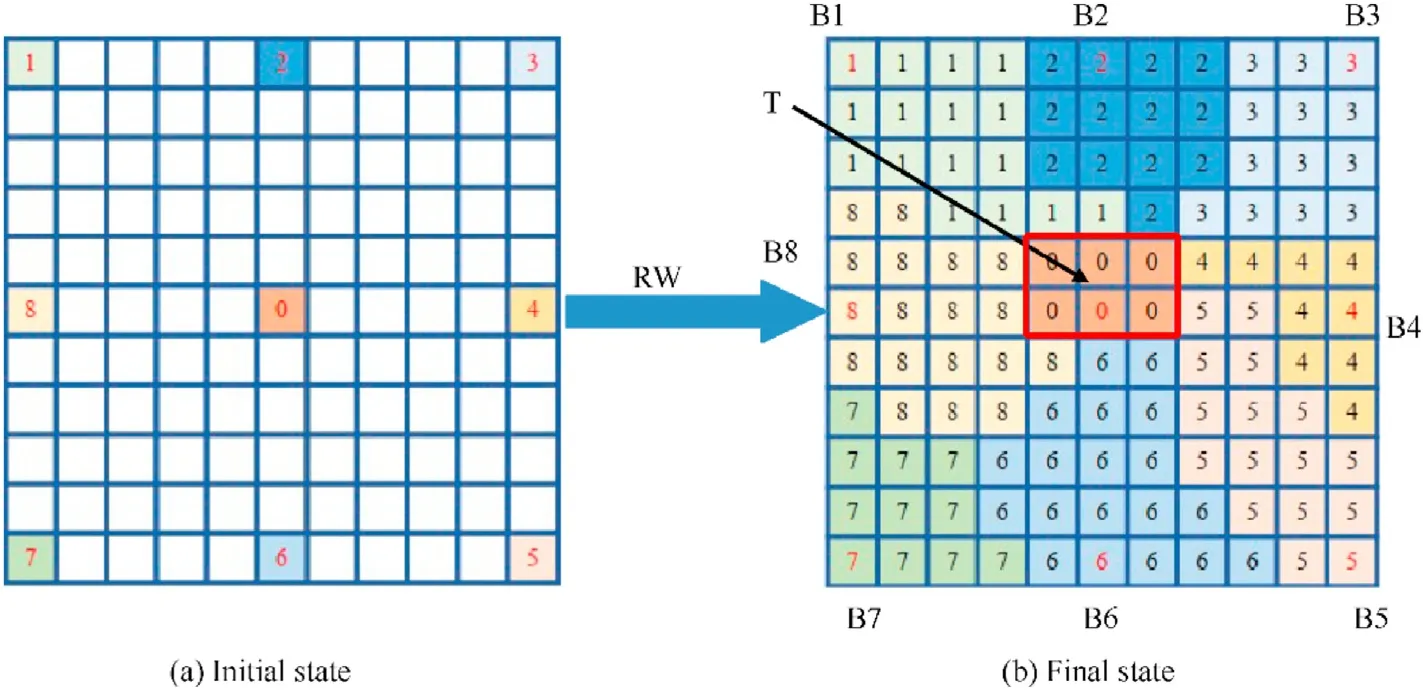
Fig.4.Schematic diagram of RW-based local window.



where L,L,and B are matrix blocks obtained by transforming matrix L according to labeled and unlabeled pixels,respectively.For an unlabeled pixel v,it will be labeled as the category kwith the highest probability.The category kis expressed as follows:

When all pixels are labeled,we obtain the final window structure as shown in Fig.4(b).In the final state,both the target and the background are accurately segmented.As shown in Fig.4(b),For simplicity,we use T and Bto denote the target area and background areas,respectively.By constructing the RW-based local window,we are able to accurately separate irregular targets even in complex backgrounds.
2.3.PLLCM calculation
In order to suppress low-contrast backgrounds and remove high-contrast LABHB,we propose a novel local contrast measure called PLLCM,which incorporates probability weights and size constraints.Fig.5 shows a real IR image with both PNHB and LABHB interference.As shown in Fig.5(a),there is usually a transition area between the IR target and the surrounding background due to thermal radiation.The gray value of the transition area is determined by both the target and the background.To measure more accurate local contrast,we propose the following PLLCM:



where pdenotes the probability that pixel vis marked with category k,gdenotes the image intensity of pixel v,and Nand Nrepresent the total number of pixels in areas T and B.PLLCMadjusts the weights according to the probability that a pixel is marked for each category,which can more accurately represent the grayscale values of each area and measure the true contrast.With PLLCM,low-contrast backgrounds can be effectively suppressed.However,accurate local contrast measurements cannot remove high-contrast backgrounds,including PNHB and LABHB.Considering that the size of small targets is defined as 2×1 to 9×9[36,53,54],we propose to apply size constraints to remove highcontrast backgrounds.As shown in Fig.5,we use H and W to denote the maximum vertical and horizontal pixel distances of area T,respectively.The size constraint for area T can be expressed as follows:

With PLLCM,both LABHB and PNHB[7]can be effectively removed simultaneously.Combining the definitions of PLLCMand PLLCM,the final PLLCM is defined as follows.To illustrate the validity of PLLCM,a brief analysis is presented below.When PLLCM is used to measure different types of pixels,the following situations may occur:

1)For a target pixel(Fig.5(a)),it can be accurately separated and it is brighter than the surrounding area.At this time,PLLCM=1 and PLLCMis very large.Therefore,PPLCM is very large,and the small target is greatly enhanced.
2)For a low-contrast background pixel,its PLLCMis small.So PLLCM is very small,it is effectively suppressed.For a LABHB(Fig.5(b)),W>9,so PLLCM=0.Therefore,PLLCM=0,it is effectively removed.
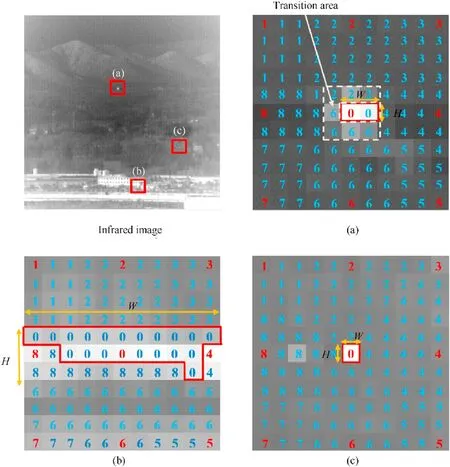
Fig.5.A raw image and RW-based local windows of representative pixels:(a)for a target pixel(b)for a LABHB(c)for a PNHB.
3)For a PNHB(Fig.5(c)),H×W<2,so PLLCM=0.Therefore,PLLCM=0,it is effectively removed.
From the above analysis,it can be concluded that after PLLCM calculation,the true small target will be greatly enhanced,and various types of interference will be removed or suppressed.
2.4.Implementation of the proposed method
As shown in Fig.2,after calculating PLLCM for all candidate pixels,we can obtain final enhanced images E.In E,real targets is bright and easy to detect.Therefore,we use an adaptive threshold operation to extract them.Considering that E is usually sparse,we define the threshold Thas follows:

where Eand Erepresent the maximum and mean values of E,and λis a constant that will be discussed in Section 3.
Based on the above preparation,we design a PLLCM-based small target detection algorithm as shown in Algorithm 1.The proposed algorithm consists of four main steps:(1)Filtering an IR image using multiscale sliding windows to obtain a coarse contrast map.(2)To improve detection efficiency,candidate target pixels are segmented using the threshold in Eqs.(3).(3)Construct RW-basedlocal windows for all the candidate pixels and calculate their PLLCMs to construct the final PLLCM enhanced map E.In E,real targets are greatly enhanced,while all kinds of interference are effectively suppressed.(4)Real targets are detected by the threshold segmentation operation shown in Eq.(14).
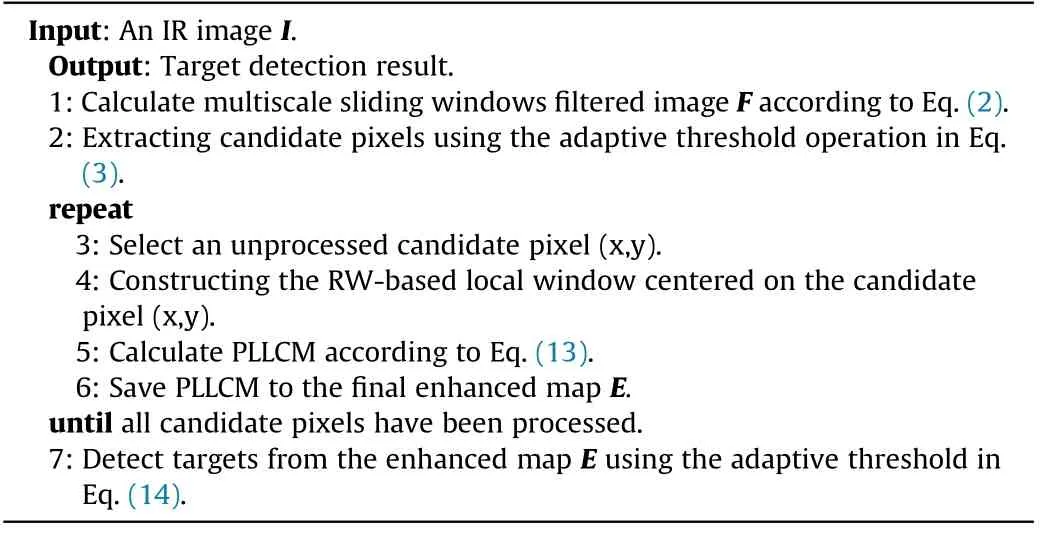
Algorithm 1Small target detection based on PLLCM.
3.Experimental results and analysis
In this section,we first introduce the evaluation metrics and the baseline methods for comparison.Then,we analyze the parameter settings and algorithm performance.Finally,various experimentsare implemented to verify the effectiveness and robustness of the proposed method.In the experiments,the parameters of baseline methods are set to their recommended values.In order to increase the diversity of the detection background,Seq.1[7,32]consists of multiple representative infrared sequences including sea and desert backgrounds.Seq.2[2],Seq.3[55]and Seq.4[55]contain 200,400 and 500 frames of real IR images,respectively.Seq.2 consists of large resolution(680×560)images disturbed by chaotic clouds and high mountains.Seq.3 and Seq.4 consist of small resolution(256×256)images disturbed by cluttered LABHB.We complete all the experiments on the PC with 8 GB memory and 3.3 GHz Intel i5 dual processor through MATLAB software.
3.1.Evaluation metrics and baseline methods
In order to quantitatively compare the performance of different small target detection methods,receiver operating characteristic curve(ROC),background suppression factor(BSF),contrast gain(CG)and average running time are selected as evaluation indicators[2].The ROC curve is composed of probability of detection Pand false alarm rate F,which are defined as follows:

Note that the deviation of a true detection is less than 5 pixels.In addition,the area under the curve(AUC)[56]is used to quantitatively compare the ROC curves.BSF is used to measure the effect of clutter suppression,which is defined as follows:

where σand σare the standard deviation of the original IR image and detection result image,respectively.CG is an indicator to measure the effect of target enhancement,which is defined as follows:

where CONand CONdenote the contrast(CON)of the original and result images,respectively.The CON is defined as:

where mand mare the average pixel value of the target area and the neighboring area around the target,respectively.The target area and the neighboring area are shown in Fig.6.Assuming the target area size is a×b,the neighboring area size is(a+2×d)×(b+2×d).In this paper,we set d to 15.In order to compare the computational complexity,the average single frame detection time on the whole sequence is also chosen as a quantitative indicator.In this paper,we choose 10 methods for comparison,including ILCM[7],LCM[43],MPCM[11],ADDCDD[44],NRAM[32],IPI[29],FKRW[2]PSTNN[10],DNGM[57]and ASPCM[42].ILCM is a traditional single-scale method.LCM and MPCM are representative multiscale methods.NRAM,IPI and PSTNN are effective PCA-based methods.ADDCDD,FKRW,DNGM and ASPCM are four latest methods.In addition,FKRW is a representative RWbased method.Details of the parameter settings for the baseline methods are shown in Table 1.
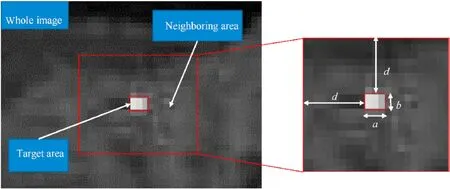
Fig.6.Schematic diagram of a small target local area in the IR image.

Table 1Parameter settings of comparison algorithms.
3.2.Parameter and performance analysis of the proposed method
(1)Analysis of Key Parameters:
The proposed algorithm contains three key parameters:the threshold parameter kfor extracting candidate pixels,the weight parameter β used in RW,and the threshold parameter λused in the final target detection.kdetermines the number of candidate pixels.When kis too large,the real target pixel may be missed,and when kis too small,residual clutter may increase.The experimental results of our method using different kon the four sequences are shown in Table 2.BSF increases with k,which means that the detection result has less background clutter.When k=6,the Pd values of Seq.1 and Seq.4 decrease first,which means that there are missed targets.In order to remove more clutter while maintaining a high detection rate,we set kto 5.2 after further experiments.The weight parameter β affects the pixellevel segmentation results.For better detection performance and robustness,our method uses different β to test on the four real image sequences.The ROC curves are shown in Fig.7.It can be seen that our method maintains excellent detection performance over a wide range of β.From the AUC values,we find that the curve with β=15 achieves the best detection performance on all the four sequences.Therefore,we set β=15 for the best overall performance in our experiments.The function of λis similar to k.After experimentation,we recommend setting it between 0.4 and 0.6.

Table 2Pd and average BSF of different kTh on the four sequences.
(2)Analysis of Robustness to Noise
Since real IR images are easily polluted by noise,robustness to noise is crucial to the performance of small target detection.To verify that our method can suppress multiple noise interferences,we added salt and pepper noise with a density of 0.001 and Gaussian noise with a density of 0.003 to IR raw images,respectively.Fig.8 shows the IR images added with salt and pepper noise and the detection results of different algorithms.As a PCA-based method that is robust to noise,PSTNN still fails to suppress PNHB.As a result,PSTNN has false alarms in Fig.8(a1)-(a2)and missestargets in Fig.8(a3)-(a4).MPCM effectively suppresses the noise in Fig.8(a1),but it fails in Fig.8(a2)-(a4)as the background becomes more complex.FKRW has good noise suppression ability and performs well in Fig.8(a1)-(a3).However,FKRW also suffers when detecting low-contrast targets and shows a false alarm in Fig.8(a4).In comparison,our method is effective in removing salt and pepper noise in different backgrounds.Fig.9 shows the IR images added with Gaussian noise and the detection results of different algorithms.In the PSTNN detection results,false alarms appear in all four images.MPCM effectively suppresses the Gaussian noise in Fig.9(a1)and Fig.9(a4),but it fails in Fig.9(a2)and Fig.9(a3)as the background becomes more complex.FKRW has good noise suppression ability and performs well in Fig.9(a1)-(a2).However,when dealing with a cluttered background of Gaussian noise interference,FKRW shows a false alarm in Fig.9(a4)and loses the target in Fig.9(a3).In comparison,our method is effective in removing Gaussian noise in different backgrounds.These demonstrate that our method has better robustness to noise,which helps to maintain high detection performance in practical applications.
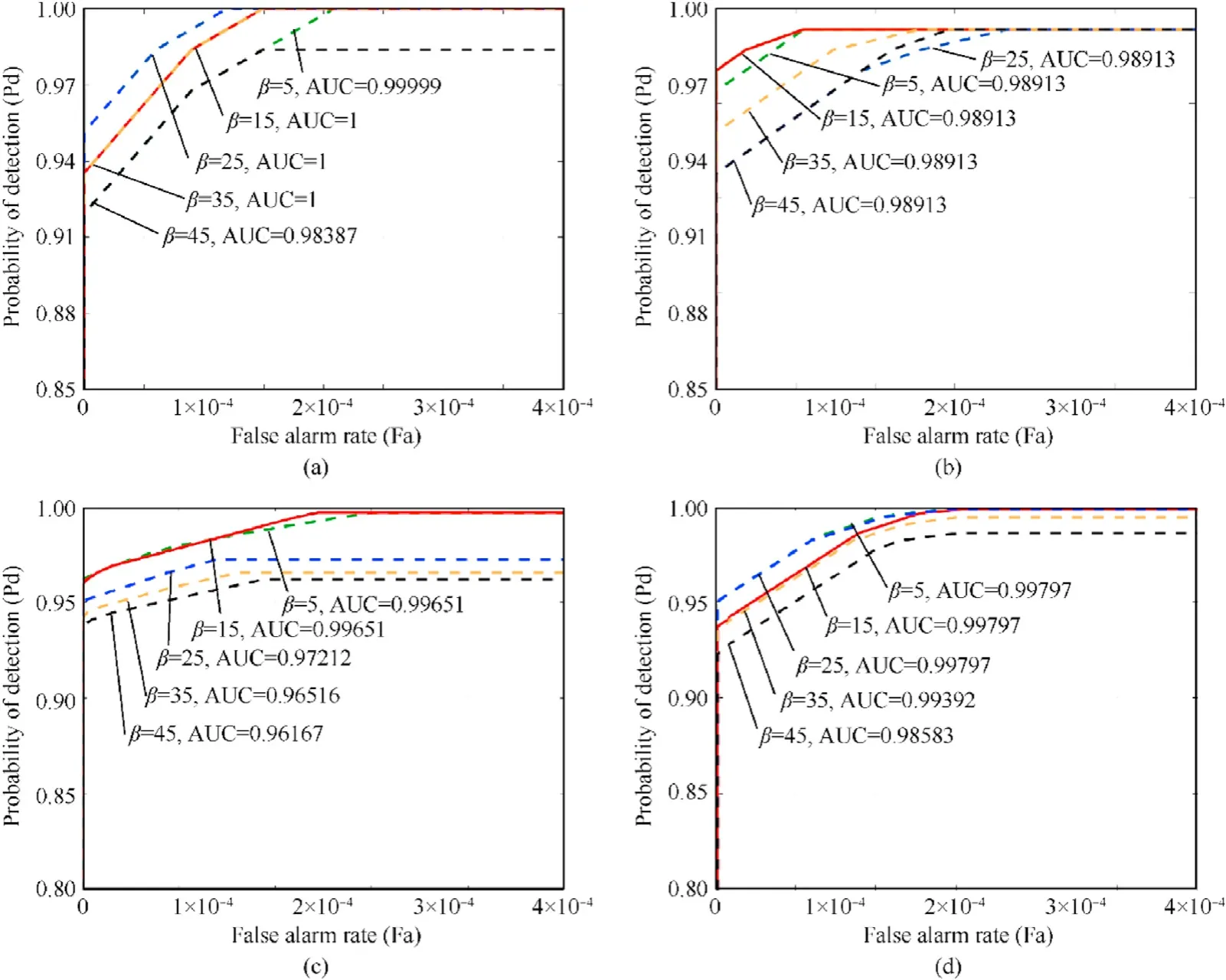
Fig.7.The ROC curves of four sequences for different β(a)Seq.1(b)Seq.2(c)Seq.3(d)Seq.4.
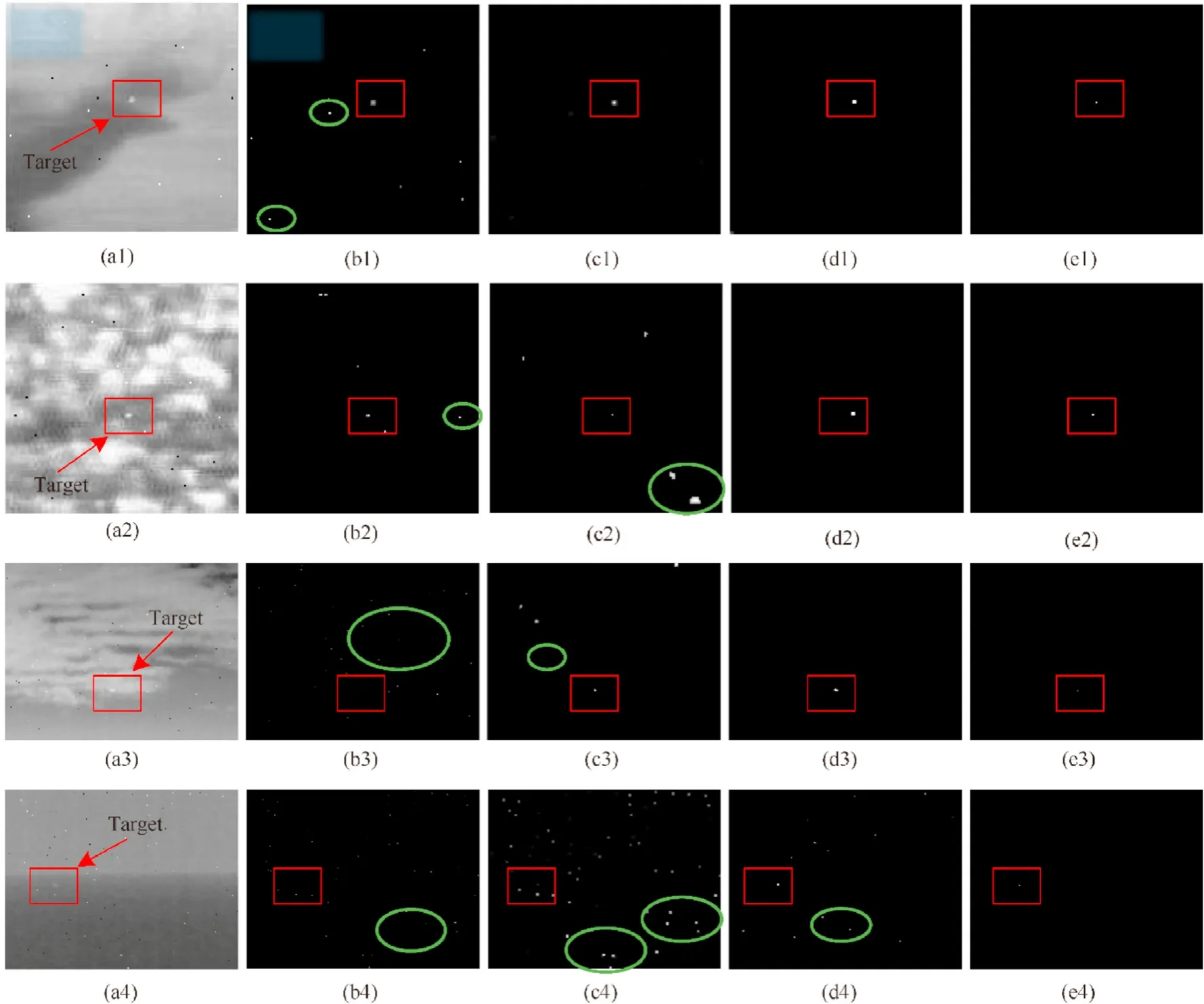
Fig.8.IR images added with salt and pepper noise and corresponding detection results.(a1)-(a4)denote IR images;(b1-b4),(c1-c4),(d1-d4)and(e1-e4)are the results of PSTNN,MPCM,FKRW and ours,respectively(the red rectangle denotes the target and the green ellipse denotes the residual clutter).
3.3.Qualitative comparison with baseline methods
In Fig.10,we compare the detection results of different methods on four real image sequences.Intuitively,our method suppresses all types of clutter and accurately detects the target in the four real sequences.Seq.1 demonstrates a weak irregular target in the typical building background containing LABHB.Since traditional HVS-based methods(ILCM,LCM,MPCM,and ADDCDD)cannot segment the target,LABHB is misdetected and the true target is lost.MPCM and ADDCDD have better clutter suppression than ILCM and LCM.Since LABHB in Seq.1 does not have non-local autocorrelation,PCA-based methods(NRAM,IPI and PSTNN)also miss the true target.By segmenting the irregular target,both FKRW and our method effectively suppress almost all the clutter including LABHB and detect the target accurately.The two latest methods(DNGM and ASPCM)also show comparable ability to suppress background clutter to our method.The weak irregular target of Seq.2 is hidden in chaotic clouds and disturbed by bright mountains(LABHB).ILCM and LCM perform the worst in terms of clutter suppression.MPCM and ADDCDD are better at suppressing clutter.However,LABHB makes them have false alarms and even miss the target.Since Seq.2 has auto-correlation,NRAM and IPI suppress most of the background.The result of PSTNN still has a small amount of clutter and causes false alarms.DNGM and ASPCM correctly detect the target but retain some high intensity clutter.Both FKRW and our method remove all clutter and accurately detect the irregular target.Seq.3 demonstrates the air-ground background containing both PNHB and LABHB.ILCM and LCM perform the worst in terms of clutter suppression.There is a small amount of residual clutter in MPCM and ADDCDD.PCA-based methods(NRAM,IPI and PSTNN)are difficult to remove PNHB and even causes false detections.False detections are also found in the result of FKRW.The reason is that itdoes not perform pixel-level subdivision of the background,which makes it ineffective in removing the cluttered LABHB.DNGM and ASPCM suppress most of the background,but retain some clutter.Our method still has the best clutter suppression in complex backgrounds.Seq.4 is a ground scene disturbed by LABHB.Traditional HVS-based methods(ILCM,LCM,MPCM,and ADDCDD)have the most background residuals.Both IPI and PSTNN have a small amount of clutter residue due to LABHB.There are also many false alarms in the results of DNGM and ASPCM.Both NRAM and our method correctly detected the target and removed almost all the background.Interfered by cluttered LABHB,the FKRW result still has background residuals,leading to a high false alarm rate.To summarize,cluttered LABHB significantly decreases the performance of FKRW,while background auto-correlation greatly affects the performance of PCA-based methods.It can be seen that our method maintains the best clutter suppression and target detection performance in the four sequences containing different interferences.In other words,our method effectively solves the existing“target suppression”problem.
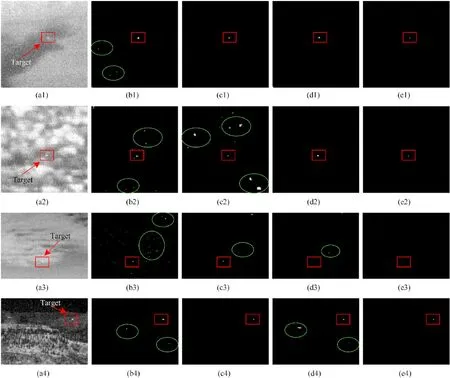
Fig.9.IR images added with Gaussian noise and corresponding detection results.(a1)-(a4)denote IR images;(b1-b4),(c1-c4),(d1-d4)and(e1-e4)are the results of PSTNN,MPCM,FKRW and ours,respectively(the red rectangle denotes the target and the green ellipse denotes the residual clutter).
3.4.Quantitative comparison with baseline methods
BSF,CG,ROC curves and average detection time are used to quantitatively compare the performance of the proposed method with the baseline methods.Note that BSF is used to measure the effect of clutter suppression over the whole image,while CG measures the effect of target enhancement in a local area.Table 3 shows the average BSF and CG of different methods on the four sequences.ILCM and LCM have the smallest BSF values,corresponding to their worst background suppression ability.ASPCM,ADDCDD,and DNGM performed better than the other baseline algorithms.ASPCM achieved the second highest BSF value on both Seq.1 and Seq.3,ADDCDD and DNGM achieved the second highest on Seq.2 and Seq.4,respectively.Our method achieves the highest BSF values on all four sequences,implying robustness and efficiency in background suppression.In terms of CG,the proposed method achieves the highest CG value on all four sequences,implying the best target enhancement.ILCM and LCM have the smallest CG values,corresponding to their worst target enhancement effects.MPCM and IPI obtained the second highest CG values in Seq.1 and Seq.4 respectively,while DNGM obtained the second highest in the other sequences.
As shown in Table 4,we analyzed the computational complexity of the different algorithms and compared their average processing time over the four sequences.Multiscale methods(LCM,MPCM and ADDCDD)calculate the significance of each pixel in an image at different scales.Therefore,their computational complexity is O(LMN),where M×N denotes the raw image size and L indicates the number of different scales.As a single-scale or adaptive-scale method,the complexity of ILCM,DNGM and ASPCM is O(MN).For PCA-based methods,the computational complexity is mainly derived from the matrix SVD.Therefore,the computationalcomplexity is O(mn),where m and n denote the rows and columns of the patch-image[29,32].PSTNN[10]reduces the complexity to O(nnnlog(nn)+nn[(n+1)/2])by optimizing the algorithm,where n×n×nrepresents the size of the patch-tensor.RLCM requires the longest processing time.As shown,PSTNN runs the fastest among PCA-based methods.The main timeconsuming operation of FKRW[2]is the application of the RW algorithm to pixels.The complexity of the RW algorithm is O(k),where k represents the number of pixels waiting to be segmented.For local operations,k is a fixed value.Thus,the algorithmic complexity of FKRW is O(MN).The complexity of our method is mainly in two steps:the first step uses multi-scale window filtering without calculating the significance of each pixel,so the complexity is O(MN);the second step calculates the PLLCM,and the complexity is O(MN).Therefore,the complexity of our method is O(MN).Although our method has the same complexity as FKRW,we achieve faster processing speed by optimizing the operation ofindividual pixels.As shown in Table 4,the average processing time of our method on each sequence is much less than that of FKRW.Because of the lower complexity,our method is much faster than LCM and MPCM in Seq.2,which consists of large resolution(680×560)images.As a whole,HVS-based methods are faster than PCA-based methods,and ILCM has the fastest processing speed.Although our method is slightly slower than the fastest algorithm(ILCM),it has the same algorithmic complexity as ILCM and runs faster than most baseline algorithms.

Table 3Average BSF,CG and processing time obtained by 10 methods on the four sequences.

Table 4Comparison of the complexity and average processing time(in seconds)of different algorithms.
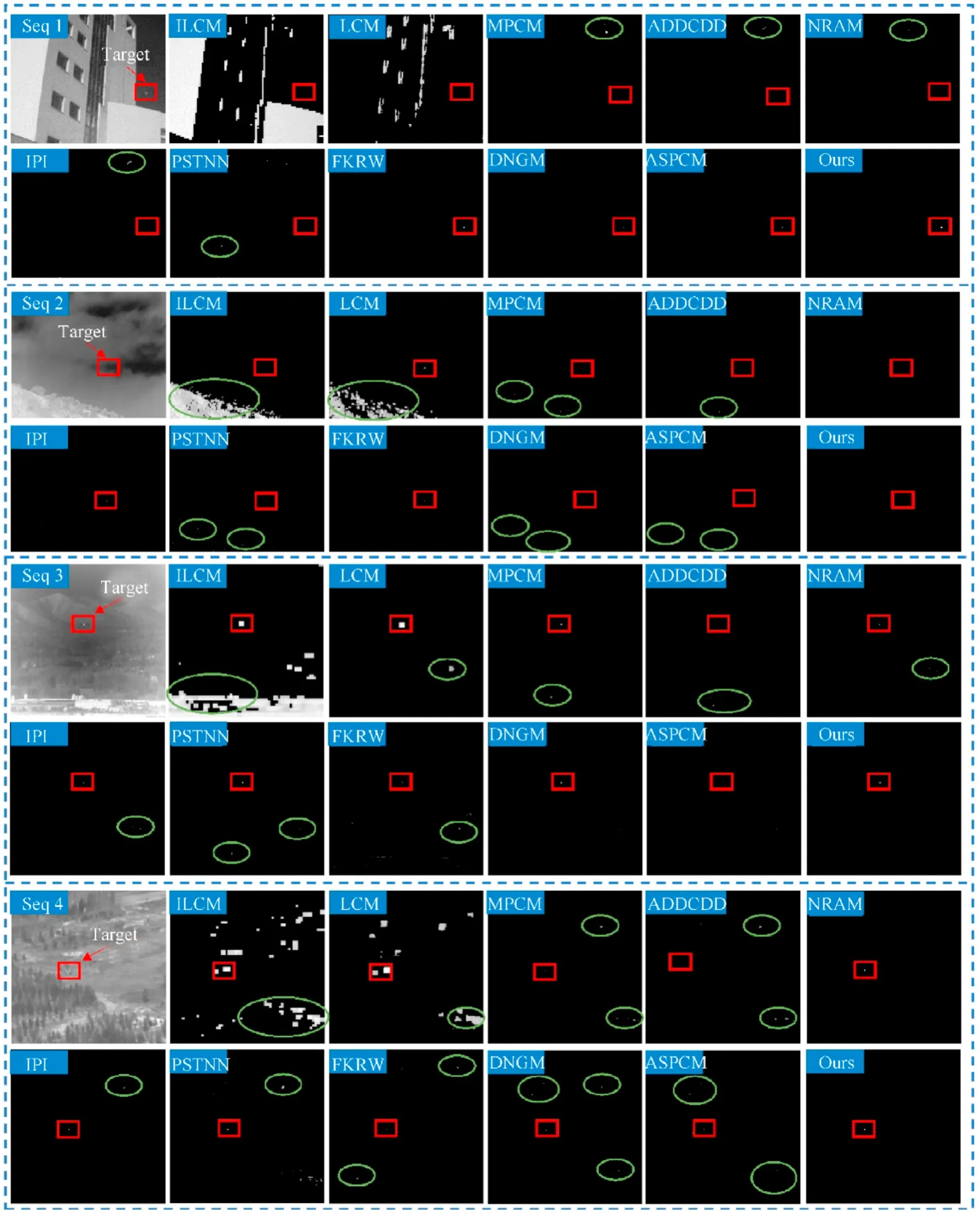
Fig.10.IR raw images and detection results of different algorithms on the four sequences(the red rectangle denotes the target and the green ellipse denotes the residual clutter).
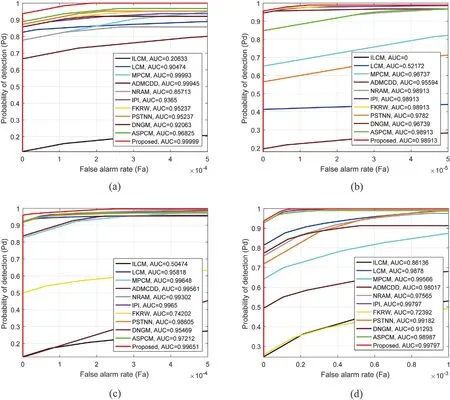
Fig.11.The ROC curves of different methods on the four sequences(a)Seq.1(b)Seq.2(c)Seq.3(d)Seq.4.
Fig.11 shows the ROC curves and AUC values of different methods on the four sequences.Larger AUC values indicate better detection performance.As can be seen from the ROC curves,the curves of our method are on top of the curves of the other algorithms for all four sequences,implying that our method has a higher detection rate at a lower false alarm rate.In addition,the maximum AUC values on all four sequences indicate that our method has the best detection performance.ILCM has the lowest curve on all four sequences and has the smallest AUC value,corresponding to its worst detection performance.FKRW performs well in Seq.1 and Seq.2,but its performance is greatly decreased in Seq.3 and Seq.4.The reason is that Seq.3 and Seq.4 contain cluttered LABHB that it cannot suppress.PCA-based methods(NRAM,IPI,PSTNN)have poor detection performance in Seq.1,mainly because the backgrounds containing LABHB do not satisfy the non-local auto-correlation.The two latest methods(DNGM and ASPCM)maintain good performance on all four sequences,but neither obtain the top two best performing performances.Experiments show that our method maintains the best detection performance in a variety of complex backgrounds.That means our method achieves better robustness and effectiveness in practical applications.
4.Conclusion
In this paper,an effective infrared small target detection method based on PLLCM is proposed.To solve the“target suppression”problem,PLLCM proposes a pixel-level segmentation of both the target and the background.By incorporating probability weights and scale constraints,PLLCM can more accurately measure local contrast and suppress background interference including PNHB and LABHB.Numerous simulations and experiments are implemented to verify the robustness and effectiveness of our method.Experimental results show that our method can better suppress various types of background interferences,such as PNHB and LABHB,and can improve target detection rates compared to several state-of-the-art methods.Moreover,the high detection performance of our method requires no increase in computational complexity and only a small increase in time consumption.
The authors declare that they have no known competing financial interests or personal relationships that could have appeared to influence the work reported in this paper.
This work is supported by the National Natural Science Foundation of China under Grant 62003247,Grant 62075169,and Grant 62061160370.
杂志排行
Defence Technology的其它文章
- 3D laser scanning strategy based on cascaded deep neural network
- Damage analysis of POZD coated square reinforced concrete slab under contact blast
- Autonomous maneuver decision-making for a UCAV in short-range aerial combat based on an MS-DDQN algorithm
- The properties of Sn—Zn—Al—La fusible alloy for mitigation devices of solid propellant rocket motors
- The surface activation of boron to improve ignition and combustion characteristic
- Numerical investigation on free air blast loads generated from centerinitiated cylindrical charges with varied aspect ratio in arbitrary orientation
